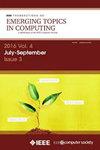SHA-2和SHA-3的量子实现与分析
IF 5.4
2区 计算机科学
Q1 COMPUTER SCIENCE, INFORMATION SYSTEMS
IEEE Transactions on Emerging Topics in Computing
Pub Date : 2025-03-07
DOI:10.1109/TETC.2025.3546648
引用次数: 0
摘要
量子计算机有潜力解决许多被认为是经典计算机几乎不可能解决的难题。这一观察结果引发了将量子算法应用于加密系统以评估其量子抗性的研究热潮。在评估针对即将到来的量子威胁的加密算法的安全强度时,精确估计量子资源需求(通常在电路深度和量子比特计数方面)至关重要。美国政府的国家标准与技术研究所规定了五个量子安全级别,以便将给定密码的相对量子强度与标准密码进行比较。在Jaques等人(Eurocrypt ' 20)的工作之后,nist指定的奇数级别(即1,3和5)的量子安全级别取得了一些进展。然而,级别2和级别4对应于SHA-2和SHA-3哈希函数的量子碰撞查找攻击,量子攻击的复杂性可以说没有得到很好的研究。这正是我们的文章适合的地方。在本文中,我们提出了在NIST指定的所有类别中优化SHA-2和SHA-3算法的量子电路实现的新技术。然后,我们评估了量子碰撞搜索中目标密码哈希函数的量子电路。最后,我们定义了第2层和第4层的量子攻击复杂度,并对扩展层的安全强度进行了评价。我们提出了在元件级和体系结构级优化量子电路的新概念。本文章由计算机程序翻译,如有差异,请以英文原文为准。
Quantum Implementation and Analysis of SHA-2 and SHA-3
Quantum computers have the potential to solve a number of hard problems that are believed to be almost impossible to solve by classical computers. This observation has sparked a surge of research to apply quantum algorithms against the cryptographic systems to evaluate its quantum resistance. In assessing the security strength of the cryptographic algorithms against the upcoming quantum threats, it is crucial to precisely estimate the quantum resource requirement (generally in terms of circuit depth and quantum bit count). The National Institute of Standards and Technology by the US government specified five quantum security levels so that the relative quantum strength of a given cipher can be compared to the standard ones. There have been some progress in the NIST-specified quantum security levels for the odd levels (i.e., 1, 3 and 5), following the work of Jaques et al. (Eurocrypt’20). However, levels 2 and 4, which correspond to the quantum collision finding attacks for the SHA-2 and SHA-3 hash functions, quantum attack complexities are arguably not well-studied. This is where our article fits in. In this article, we present novel techniques for optimizing the quantum circuit implementations for SHA-2 and SHA-3 algorithms in all the categories specified by NIST. After that, we evaluate the quantum circuits of target cryptographic hash functions for quantum collision search. Finally, we define the quantum attack complexity for levels 2 and 4, and comment on the security strength of the extended level. We present new concepts to optimize the quantum circuits at the component level and the architecture level.
求助全文
通过发布文献求助,成功后即可免费获取论文全文。
去求助
来源期刊

IEEE Transactions on Emerging Topics in Computing
Computer Science-Computer Science (miscellaneous)
CiteScore
12.10
自引率
5.10%
发文量
113
期刊介绍:
IEEE Transactions on Emerging Topics in Computing publishes papers on emerging aspects of computer science, computing technology, and computing applications not currently covered by other IEEE Computer Society Transactions. Some examples of emerging topics in computing include: IT for Green, Synthetic and organic computing structures and systems, Advanced analytics, Social/occupational computing, Location-based/client computer systems, Morphic computer design, Electronic game systems, & Health-care IT.
 求助内容:
求助内容: 应助结果提醒方式:
应助结果提醒方式:


